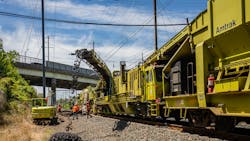Amtrak advances Northeast Corridor improvements
Amtrak will make necessary infrastructure improvements between Washington, D.C., and New York as part of a larger effort to improve the railroad, bring it to a state of good repair and to enhance the overall customer experience.
Amtrak has committed approximately $130 million for rail improvements, of which more than $55 million will be performed this summer. The railroad has also hired 500 new employees to complete these projects and will continue to hire additional workers.
“Amtrak continues to prioritize updating our infrastructure to improve service reliability on the Northeast Corridor,” said Amtrak Executive Vice President of Capital Delivery Laura Mason. “Modernizing and investing in infrastructure is a continuous process on the railroad and we thank our partners for their coordination and flexibility as we advance these important projects.”
Once complete, Amtrak says these projects will reduce the likelihood of lengthy train delays and significantly improve ride quality for customers. Train schedules have been adjusted to account for this work and to avoid conflicts with other commuter agencies, however, minor delays may be expected. For each project, Amtrak’s production team will be working the night shift and heavy production will occur on weekend nights to minimize impacts for customers.
Specifics of the work include:
- Replacing 40 track switches throughout New York and the Northern and Southern Mid-Atlantic regions.
- Updating up to 25 miles of track in the Southern Mid-Atlantic Region.
Additionally, customers should be aware that high temperatures in the warm summer months can also impact Amtrak operations as the extreme heat can cause rail, bridge and overhead wires to expand. As a safety measure, Amtrak occasionally enacts temporary heat restrictions as needed, which require locomotive engineers to operate trains at lower speeds than under normal operating conditions. Speed reductions are based on the rail temperature, not the ambient (air) temperature. That data ensures that heat restrictions are only implemented when necessary, adds Amtrak.
